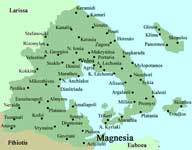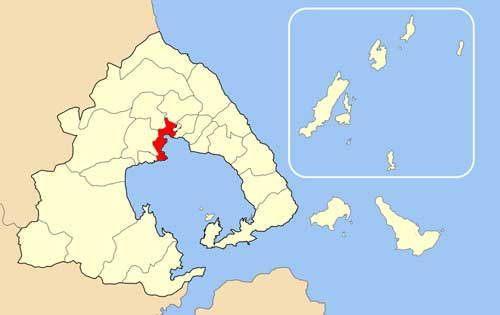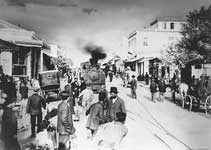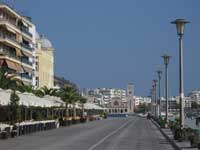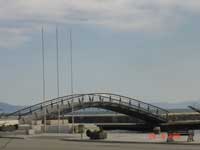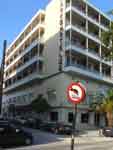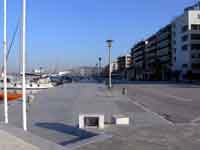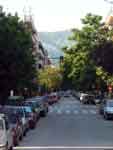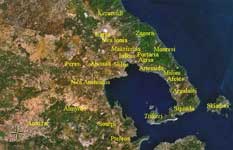.
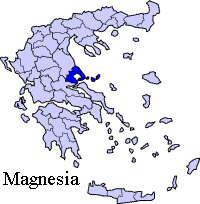
|
Municipality of Volos |
Volos
Volos (Greek: Βόλος) is a coastal port city in Thessaly situated midway on the Greek mainland, about 326 km north of Athens and 215 km south of Thessaloniki. It is the capital of the Magnesia peripheral unit.
Overview
Built at the innermost point of the Pagasetic Gulf and at the foot of Mount Pilio or Pelion (the land of the Centaurs), Volos is the only outlet towards the sea from Thessaly, the country's largest agricultural region. With a population of 144,420 (2011) and a prefecture of around 200.000, it is an important industrial centre[CN], while its port provides a bridge between Europe, the Middle East and Asia. Volos is the third of Greece's major commercial ports, but also gains significant traffic because of its connections by ferry and hydrofoil to the nearby Sporades Islands, which include Skiathos, Skopelos and Alonissos. There are also connections to Limnos, Lesvos, Chios and Skyros.
Volos is the newest of the Greek port cities, with a remarkably large proportion of modern buildings, erected following the catastrophic earthquakes of 1955.[CN] It includes the municipalities of Volos, Nea Ionia and Iolkos, as well as smaller suburban communities. The economy of the city is based on manufacturing, trade, services and tourism, and with its improved infrastructure the city is becoming more dynamic. Home to the University of Thessaly, one of the most important in the country, the city also offers a wide range of facilities for the organisation of conferences, exhibitions and major cultural and scientific events, together with international-standard sporting amenities.
Volos participated in the 1996 Olympic Games, and as an Olympic City it helped to present a new face of contemporary Greece to a world audience. The city has also since played host to a succession of athletic events, such as the European Athletic Championships.
History
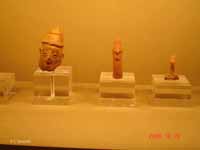
Antiquity
Further information: Ancient Greece and Hellenistic Greece
The return of the Argonauts by Constantine Volanakis (1837–1907).
Modern Volos is built on the area of the ancient cities of Demetrias, Pagasae and Iolcos. Demetrias was established by Demetrius Poliorcetes, King of Macedon. Iolkos, Iolcos or Iolcus, was the homeland of mythological hero Jason, who boarded the ship Argo accompanied by the Argonauts and sailed in quest of the Golden Fleece to Colchis. To the west of Volos lie the Neolithic settlements of Dimini, with a ruined acropolis, walls, and two beehive tombs dating to between 4000-1200 BC, Sesklo, with the remains of the oldest acropolis in Greece (6000 BC), and also the foundations of a palace and mansions, among its most characteristic examples of Neolithic civilisation.
Byzantine era
Further information: Byzantine Greece
According to a Byzantine historian of the 14th century, Volos was known as "Golos" (Greek: "Γόλος"). The most widely accepted theory for the derivation of the city's name suggests that Volos is a corruption of the Mycenaean Iolkos, which had become distorted through the ages to become "Golkos", later "Golos", and subsequently "Volos". Others contend that the name originates with Folos, who according to myth was a wealthy landlord of the region. It was conquered by Stefan Dusan, was king of Serbia in 1348 and was managed for 25 years. Volos returned to Byzantine rule in 1373 but was conquered by Ottomans in 1393. Volos returned to Byzantine again in 1402 but Ottomans retook it in 1423.
Ottoman era
Further information: Ottoman Greece
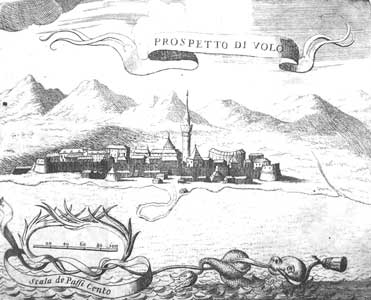
Ottoman Castle ,Volos, Vincenzo Maria Coronelli (1650-1718): Prospetto di Volo,(Giuseppe Maria Ruinetti print 1688)
The city marked a Southern border of Vilayet-i Rumeli-i Şarki in the Ottoman Empire, known then as "Golos". It was as kaza centre in Tırhala sanjak and was bounded to Yanya, Selanik and Manastır vilayets after the second half of 17th century. Since the early stages of the Greek Revolution, the provisional government of Greece claimed Volos as part of Greek national territory, but the Treaty of Constantinople (1832), which established a Greek independent state, set its northern boundary between Arta and Volos.[1]
Russian Consulate of the wider area during Ottoman Era, the Pelion Tower of Ano Lechonia
Modern Volos
The port of Volos by Constantine Volanakis (c.1875).
Volos' promenade.
The church of Saints Constantine and Helen at the seafront.
Volos is a relatively new city, beginning its strongest growth in the mid 19th century where an insignificant Turkish hamlet used to lie. According to local evidence, the modern town was first established in 1841. One of its first known inhabitants was an Epirote, Nicolaos Gatsos; according to travellers of the time he laid the foundation stone for its first house. The locality of its castle was named Golos by Ottomans and locals, while Ano Volos was known as Gkolos, although some historians suggest Kastria of Volos. In 1830 Koumas referred to it as Iolkos; others also referred to it as Nea Demetrias, after ancient Demetrias.
In 1858 the town had just 80 houses, most of which lay along the waterfront, approximately where Iasonos Street can be found today. After its incorporation into Greece from the Ottoman Empire in 1881, the town had a population of only 4,900, but grew rapidly in the next four decades as merchants, businessmen, craftsmen and sailors gravitated toward it from the surrounding area. In the 1920s a large influx of refugees to the settlement took place, especially from Ionia, but also from Pontus, Cappadocia and Eastern Thrace. In 1882, Andreas Syngros established the Privileged Bank of Epirus and Thessaly, which the National Bank of Greece acquired in 1899 after its founder's death. Volos was occupied by Ottomans in 8 May, 1897 during Greco Turkish War. This occupation was lasted 5 months.
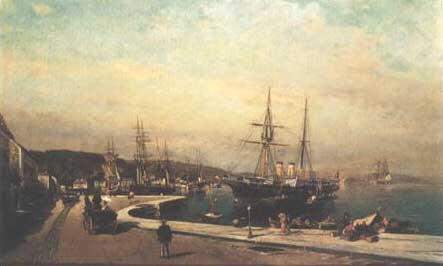
Konstantinos Volanakis, The Harbour of Volos (Το λιμάνι του Βόλου) (1875;). 32.5 cm x 48 cm. National Gallery and Alexander Soutsos Museum
In its 1920 census, Volos recorded 30,046 inhabitants, but by the 1928 census the figure had grown to 47,892. In fact, Volos had a total population of 41,706, with the refugees of the "Asia Minor Catastrophe" comprising 6,779 of these (16.25%). In the Nea Ionia district, the total population was 6,186, and the refugees 5,166 (83.51%). Overall, the total number of refugees in the Municipality of Pagasses (Volos and Nea Ionia) numbered 11,945, of which refugees accounted for 25%.
The development of the city was closely bound up with the establishment of its industrial estate, the upgrading of the port, and the growth of tourism, due to the city's location near the scenic Mt. Pelion, the home of Chiron the Centaur and the beautiful beaches of the Magnesia Prefecture, particularly those of the Northern Sporades. The city has been linked with a number of significant social movements in the past, such as the early teaching of Dimotiki, by Delmouzos in the early 20th century (when Katharevousa was the officially sanctioned version). Volos is also well known for its assortment of mezedes and a clear, alcoholic beverage known as tsipouro.
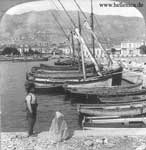
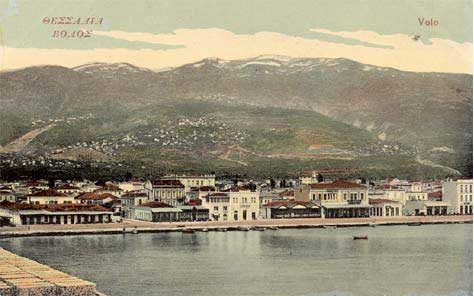
Volos c. 1912/13 (maybe a photo taken by Stefanos Stournaras)

Volos Harbour Stamp
A street in a sister city, Rostov-on-Don, bears the name Улица Греческого Города Волос (Street of the Greek City of Volos), weaving through a picturesque mix of early 20th century century buildings with characteristic inner yards, tiered balconies and open iron stairs that lend the old Rostov its characteristic Mediterranean look.
Municipality
The municipality Volos was formed at the 2011 local government reform by the merger of the following 9 former municipalities, that became municipal units:[2]
Agria
Aisonia
Artemida
Iolcos
Makrinitsa
Nea Anchialos
Nea Ionia
Portaria
Volos
Geography
Volos is the administrative centre of Magnesia peripheral unit. Many of the city domains are separated through natural barricades, such as rivers.
Three main rivers/mountain torrents all rise from mount Pelion (1651m), crossing the city to create a unique urban geography, before ending in the Pagasetic Gulf flowing west. The Anavros river, famous for Jason's pass, divides Nea Demetriada district from the rest of the urban area. Krausidonas is the major river passing through the city, and constitutes the natural lung of the urbanized area of Volos, as well as the boundary between the major municipalities of the metropolitan city, the municipalities of Volos and Nea Ionia. Xirias (Ξηριάς), is the largest torrent of the metropolitan urban area of Volos, and passes through the Nea Ionia municipal area.
Of great importance for the biological diversity of the area, and the preservation of its climate, is the swamp of Bourboulithra, a wide aquatic ecosystem located west of the city center at Neapoli district. The main feature of this wetland is the apparent rarity of its survival in a densely populated urban area and among port facilities, and its significant level of biodiversity, with over 100 species observed by the established watch post of the Ecological Initiative of Magnesia.[CN] Today as the port expands, a new threat rises for the river delta at the northern point of the Pagasetic Gulf, affecting the richness of its flora and fauna.[CN]
The city boundary at its south-eastern corner is considered one of the main foothills of Mount Pelion, the hill of Goritsa, which separates the city from Agria. The paleolithic settlement at its higher reaches is a centre for recreational activities.[CN]
Climate
Climate graph of Volos.
Volos, as a Mediterranean city, experiences a typical climate of neither particularly high nor extremely low temperatures throughout the year. Its climate is one of a low humidity, favourable for all kinds of activities. The Pelion mountain, with its own microclimate, affects the city's weather. The graph below illustrates Volos' climatic conditions.
Natural disasters
As Greece lies in an earthquake zone, Volos cannot be excluded. A number of earthquakes have left their imprint in various domains of the city's life from urban planning to residential house design. The most well-known and devastating took place in 1954-1955, nearly demolishing the entire city including all its historic neoclassical buildings. Later that same year, a flood came to completely destroy what had been talked of until then as the urban miracle of modern Greece.
The city of Volos was flooded on October 10, 2006, in one of the prefecture's worst recorded floods; the inundation devastated crops, groves and many homes. A railroad bridge connecting Volos and Larissa collapsed when the central stone support was ruined by a combination of rocks, mud and debris carried by a swollen river, and almost one fifth of the city faced severe mudslides.
Urban plan
Architecture
View of the port.
The Archaeological Museum of Volos.
A snapshot from the promenade.
The architectural and urban setting of Volos is characterised by its grid of squares and streets, its sense of neighbourhood, its imposing neoclassical buildings, the aged industrial edifices, a number of green oases, and most obviously by the proximity of sea and harbour. These elements in combination lend Volos its atmosphere and distinctiveness, making up one of the most beautiful Greek cities. The current urban plan of Volos was largely established in 1882, shortly after the liberation of the city, and was greatly influenced by concepts of neoclassical town planning. The plan connected the two city-centers (The Castle and Nea Magazia) along a simple axis; it was, however, somewhat limited given the full development possibilities of the city. The arrival of its refugees in 1922 and the earthquakes of 1955 gave Volos its present form.
Nea Magazia
Nea Magazia began construction in 1841, on the basis of a geometrically designed plan. Characteristic of this plan are the road axes lying parallel to the shore, along which developed shops and dwellings, and its central road axes today are Dimitriados street, Iasonos Street, K. Kartali Street, Diminiou, Iolkou Street and Ermou street.
Neoclassical buildings
The development of the new city coincided with the flourishing of neoclassicism. Public buildings conformed to this style and prestigious private buildings belonging to prosperous merchants were particularly sophisticated. Typical examples include:
The 3-storeyed Hotel de France, with its impressive decorative murals (1894, Iasonos and K. Kartali Street)
The National Bank, formerly the Epirothessalian Bank(1895)
The Athens Bank (1903, today the library of University of Thessaly)
The Achillopouleion Hospital (1901)
The Archaeological Museum of Volos, Athanasakeio (1909)
The Agricultural Bank (1909, formerly the Kosmadopoulos Bank)
The Cinetheater Achillion, (1925)
The Aegli Hotel, (1927), designed by Kassiopoulos
The Building of the Air-force High officials Club near Agios Konstantinos Park, believed to have been designed by Le Corbusier
The Bank of Greece (1935)
The Averofeian courts of Justice
The family houses of Kartalis, Glavanis, Kastemis, Saratsis
The Sarafopoulos Mansion (1927), today the Volos Club
The well preserved Regas house and its singular decorative murals, today the Lyceum of Greek women.
Industrial buildings
Volos' factories and tobacco warehouses constitute striking architectural examples of the industrial acme of the city toward the latter years of the 19th century, and particularly of the first half of the 20th century. Mainly centred on the railway and the harbour, but also within the city, their construction and design was often undertaken by well-known architects and engineers from around Europe. Many survive to this day following restoration and changes of function: outstanding among them are the Stamatopoulos engine-works(1883), the Glavani-Kazazi factory (1896), the Papageorgiou textile workshop (1905), the Mortzoukou textile workshop (1908), the Adamopoulos cotton industry plant (1908, today a gymnasium), the Papagianopoulos steel works (1909), the Volos Electricity Company Plant (dating to 1911 and today the musical and theatrical centre of Volos), the Tsalapatas brickworks factory (1925, today the National museum of Industrial Archeology), the Etmektzoglou silkworks (1926, today the Silk Museum), the Spirer Tobacco warehouse (1926 home of the Drury University Center), the Styxnokarpos Factory (1929), the Papastratos Tobacco warehouse, and the Matsangos Tobacco warehouse, amongst many.
Nea Ionia Refugee settlement
The history of Nea Ionia, Magnesia, is linked with the Asia Minor disaster, the torching of Smyrna and the displacement of 2,000,000 Greeks and Turks from their often affluent ancestral homes. In late February 1924 refugee houses were erected on the arid land of Xirokambos; these were known as Tetragona, or Squares, and formed the Volos refugee settlement. In the summer of 1925 the first houses were complete, called Tsimedenia, and built at the west end of the central square, whilst some years later the Petrina appeared further west. Together with the Tzamaliotica and Germanica houses at the east they make up the atmosphere of the settlement tangible today. Many of these structures still present their original appearance, while others have been partially rebuilt with new functions (municipal uses). There are plans to rebuild the area around the central square to incorporate wider uses than those of the present day.
Demographics
A street of Volos.
Volos is a relatively new city, and according to local statistics, its growth was substantially launched in 1881 when the area became part of the former Greek Kingdom. At this time the city had a population of around 4,000, mostly distributed around the old castle city (Palaia District today). Over the following century the city multiplied its population, reaching an overall population of approximately 150,000, including both permanent and temporary citizens, as well as university students.
A large proportion of the population (today, around 34% of the total) derives from the refugee population, established in the area in 1924, while another population group, comprising almost 30%, are the internal immigrants of Thessaly, whose consolidation began in 1890 and reached its peak in the late 1970s. The remaining population is mainly from Pelion and Almyros county, as well as from elsewhere in Greece. A significant number of inhabitants from elsewhere in Europe have also lived and continue to live in the city.
The city represents a fully urbanized Greek city with a large population in tertiary employment; 52%; 42% in secondary and less than 6% in primary employment. Volos today attracts more than 65% of Magnesia's perfectural population.
Historical population
Year Town population Metropolitan population
1981 71,378 103,000
1991 77,192 120,000
2001 141,675 150,000
Economy
Volos is one of the most industrialized provincial cities of Greece, due to its strategic location between the largest population centers of the country (Athens - Thessaloníki) and its port. Industry is intensely specialized in steel production and manufacturing, and METKA has two large factories in the industrial area of Volos, while large factories of SIDENOR - a steel producer - operate in close proximity from the nearby city of Almyros. Hellenic Steel industry (Ελληνική Χαλυβουργία) also has production facilities in Volos, and AGET - Hraklis, a member of the Lafarge group, operates one of the largest cement facilities in the world (with capacity exceeding 7,000,000tn[3]) with its own private port, next to the city. Volos is also active in the research sector, hosting the CERETETH.
International consulates
The city of Volos has always had a major role in the financial, economic, commercial and administrative matters of the region of Thessaly and Central Greece, due to the strategic position of the city's port, unique between Athens and Thessaloniki. Several European countries have established consulates in Volos including:
Italy Italy
France France
Belgium Belgium
Germany Germany
Denmark Denmark
Netherlands Netherlands
Culture
Vangelis Papathanasiou (Vangelis).
Giorgio de Chirico (1888-1978) was born in Volos.
Tsipouro.
Spetsofai, traditional dish with country sausage, onion, peppers and tomato, originating from the region of Pelion.
People
Ancient
Jason, mythological hero
Peleus, mythological hero
Chiron, mythological creature
Modern
John Argyris, engineer (1913–2004)
Giorgio de Chirico, painter (1888–1978)
Yorgos Foudoulis, musician and composer (1964)
Phaidon Gizikis, army officer and President of Greece during the junta (1917–1999)
Lavrentis Mahairitsas, musician and songwriter (1956)
Yiorgo Moutsiaras, orchestral conductor (1976)
Theophilos Hatzimihail, painter (1871–1934)
Kostas Papahristos, actor (1916–1995)
Vangelis, composer (1943)
Vasileios Polymeros, rower, olympic medalist (1976)
Nikolaos Skiathitis, rower, olympic medalist (1981)
Paraskevi Tsiamita, athlete (1972)
Olga Vasdeki, triple jumper (1973)
Sofia Vembo, singer (1910–1978)
Sports
Professional clubs
Α.Σ. ΕΡΜΗΣ
Olympiakos Volou FC
Niki Volou FC
Panthessaliko Stadium.
Museums and galleries
Archaeological Museum of Volos[4]
Modern History Museum of Volos City [5]
National Railway Museum of Greece, Railway Station of Volos
Tsalapatas, National Museum of Industrial History[6]
Silk Museum, at Nea Ionia, Magnesia
[ Zogia Museum Gallery]
[ Kitsos Makris Folklore Museum]
Athanasios Koutroumbas Insect Museum
Transport
All land transport reaches Volos, while the International Airport of Central Greece in Nea Anchialos links the city to international destinations, and the Port of Volos provides links to the islands, mostly the Sporades, as well as to some destinations in Pilio.
Motorways
Volos is linked through Greece's E75 Highway Axis (most often known as PATHE) with Northern and Southern Greece. Beyond this, the Axis E65 will be the gateway to Western Greece and the port of Igoumenitsa, through the plains of inner Thessaly; this part of the E65 motorway will be completed by 2012.
Airport
The city of Volos, along with the rest of Central Greece, is linked to the rest of Greece and Europe by the Nea Anchialos National Airport. The airport represents the biggest air lane in Greece after Eleftherios Venizelos, with a capacity of 800 passengers per hour and facilities for almost 10 aircraft.
Volos (Βόλος) is the first city in Europe to feature Seaplane Services through Argo Airways, which is based in Volos. The seaplanes connect Volos with Skiathos, Skopelos, Allonisos, Athens and Thessaloniki.
Railway
The railway station
Volos' railway station building was designed by Evaristo De Chirico soon after the liberation of Central Greece. Part of the station still functions in this picturesque 1884 structure, reminiscent to some of a stately home. The adjacent neoclassical building, built between 1900 and 1903 under Evaristo De Chirico, served as the administrative headquarters of the Thessaly Railways.
Today, the city is served by direct lines to the rest of Greece, and the railway complex houses facilities for train maintenance. Volos is directly linked with Athens once per day, with Thessaloniki twice per day, and with Larissa 15 times a day. In the past Volos was served by railway lines of three different gauges, the metre gauge line of Thessaly Railways to Kalampaka, the standard gauge line to Larissa and the 600 mm line to Pelion. Remnants of triple gauge lines still exist near the station.
International relations
See also: List of twin towns and sister cities in Greece
Twin towns — Sister cities
Volos is twinned with:
France - Le Mans, France
Bulgaria - Pleven, Bulgaria
Russia - Rostov-on-Don, Russia
Serbia - Smederevo, Serbia
Russia - Sochi, Russia
Chile - Antofagasta, Chile
See also
Panthessaliko Stadium
References
^ Comstock, John (1829). History of the Greek Revolution. New York: W. W. Reed & co.. p. 5.
^ Kallikratis law Greece Ministry of Interior (Greek)
^ "AGET Hraklis Facilities".
^ vagelis tsekeris. "Archaeological Museum of Volos". Travelinfo.gr. Retrieved 2009-07-27.
^ "ΜΟΥΣΕΙΟ ΠΟΛΗΣ - Σχεδιασμός". www.i-politismos.gr. Retrieved 2009-07-27.
^ "::: Piraeus Bank Group Cultural Foundation :::". Piop.gr. Retrieved 2009-07-27.
See
Archaeological Museum of Volos
|
Municipalities and communities of the Magnesia Prefecture
Afetes | Agria | Aisonia | Almyros | Alonnisos | Argalasti | Artemida | Feres | Iolkos | Karla | Milies | Mouresi | Nea Anchialos | Nea Ionia | Portaria | Pteleos | Sipiada | Skiathos | Skopelos | Sourpi | Volos | Zagora Anavra | Keramidi | Makrinitsa | Trikeri |
| Ancient Greece
Science, Technology , Medicine , Warfare, , Biographies , Life , Cities/Places/Maps , Arts , Literature , Philosophy ,Olympics, Mythology , History , Images Medieval Greece / Byzantine Empire Science, Technology, Arts, , Warfare , Literature, Biographies, Icons, History Modern Greece Cities, Islands, Regions, Fauna/Flora ,Biographies , History , Warfare, Science/Technology, Literature, Music , Arts , Film/Actors , Sport , Fashion --- |
Retrieved from "http://en.wikipedia.org/"
All text is available under the terms of the GNU Free Documentation License


